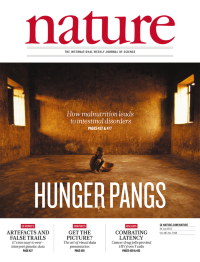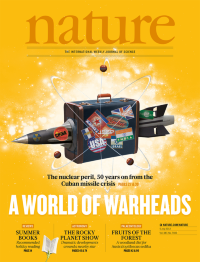Volume 487
-
No. 7408 26 July 2012
Malnutrition affects many millions of people in the developing world and remains a problem in wealthy nations, especially for disadvantaged groups. In many cases, it is the associated diarrhoea and intestinal inflammation that cause morbidity and death. A study published in this issue presents a molecular explanation for the increased susceptibility to intestinal inflammation in malnutrition. Angiotensin converting enzyme 2, which has a central role in blood-pressure regulation and has been implicated in diabetes, heart failure and viral infection, is shown to influence dietary amino-acid homeostasis, innate immunity, gut microbial ecology and susceptibility to colitis. Mice deficient in this enzyme show impaired tryptophan metabolism and develop colitis, which is alleviated by dietary tryptophan and its metabolite, nicotinamide. This surprising result explains nutritional effects that have been known for centuries and provides a molecular link between malnutrition and the intestinal microbiome. Cover: 22 March 1993, a victim of famine in Ayod, South Sudan (Jon Jones/Sygma/Corbis).
-
No. 7407 19 July 2012
With 8 eight days to go to the opening of the 2012 London Olympics, we reflect on some scientific aspects of sport. Sports authorities will be hoping that anti-doping measures (see News Feature p. 290) are tight enough to deter and detect any cheats. But some argue that we should not try to hold the line against enhancement. If made legal, enhancement strategies could produce superathletes (News Feature p. 287) to improve the show. Or, as part of a regime including genetic enhancement modification and rule changes, enhancement could level the playing field for competitors unlucky enough to have the wrong sort of genes (Comment p. 297). All the fuss about sport might suggest that we were born and evolved to run. Yes, say Michael Spedding and Tim Noakes (Comment p. 295), but at a cost. In todays world, the physiology that got us this far makes us vulnerable to disease. Cover image: Michael Blann/Getty
-
No. 7406 12 July 2012
Heat cycles provide almost all of the energy that a modern civilization consumes. The thermoelectric cycle, a latecomer compared with steam and gases, generates electrical power through the Seebeck effect, whereby an electric voltage is generated when a conductor is placed in a temperature gradient. The 2008 discovery of the spin Seebeck effect (go.nature.com/dlvhz2) whereby a thermal gradient applied to a spin-polarized material leads to a spatially varying transverse spin current in an adjacent non-spin-polarized material — led to a new line of research in spintronics. In this issue of Nature, Jaworski et al. describe something similar but three orders of magnitude more powerful, 'giant spin Seebeck effect' in a material (indium antimonide, InSb) that is non-magnetic but that has strong spinorbit coupling and phononelectron drag. They propose a mechanism for this phenomenon that relies on spin polarization only, not on magnetic exchange. The results, say the authors, show that the spin Seebeck effect can be of a magnitude that may make spin-based thermal-energy converters a reality, and possibly competitive with existing technologies. Cover: IMAGE BY Scott Denison © Roberto C. Myers & Joseph P. Heremans.
-
No. 7405 5 July 2012
Recently released papers and tapes have revealed that the United States and the Soviet Union came even closer to a nuclear exchange during the Cuban missile crisis of 1962 than many realized at the time. In Comment, David Gibson examines the decision-making processes that took the world to the brink and back. Today, with nine nuclear-weapons states and counting, the world may be an even more dangerous place. Scott Sagan argues that although there is something in the claim that the two cold war superpowers achieved an uneasy balance that prevented conflict, no such stability can be achieved between multiple nuclear-weapons states. Sagan sees arms reduction as essential, with the halfway house of slimmed-down nuclear arsenals as a worthwhile intermediate goal. Cover: Viktor Koen.




